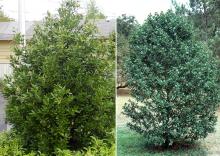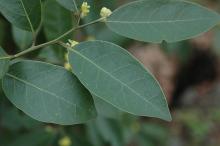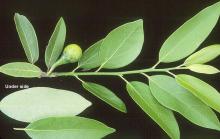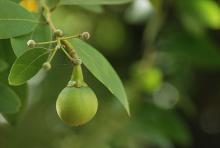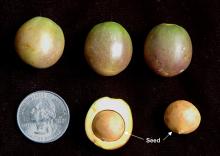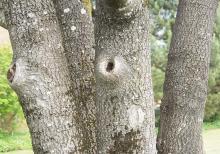Umbellularia californica
Common name:
Oregon Myrtle
California Bay
California-laurel
Pronunciation:
um-BEL-ew-lah-ree-a ka-li-FORN-i-ka
Family:
Lauraceae
Genus:
Type:
Broadleaf
Native to (or naturalized in) Oregon:
Yes
- Broadleaf evergreen tree/shrub, 25-30(70) ft (7.6-9(21) m) high, loose foliage in shade, but a round, gum-drop habit when in the open. Leaves alternate, simple, elliptical or lance-shaped, 5-13 cm long, thick and leathery, margin entire and slightly thickened and revolute (turned under), shiny dark green above and dull and lighter below; very aromatic. Clusters of small, creamy white flowers in early spring, but thereafter may flower sporadically for several months. Fruit about 2 cm long, elliptical to nearly round, greenish to purple, maturing in late autumn.
- Sun or shade. When established, which may be difficult, it grows in any rich, moist, well-drained soil. The leaves cause skin irritations in some people and aromatic components in the leaves may cause sneezing and headaches if inhaled. Native peoples used the leaves to repel fleas and to treat headaches and poison oak dermatitis.
- This is NOT the source of "bay leaves" generally used in cooking. Bay leaves are from Laurus nobilis (True Laurel, Bay Laurel), which also is a member of the family Lauraceae but it is native to the Mediterranean region. The leaves of Umbellularia californica are sometimes used as a bay leaf substitute but they have much stronger flavor. The Oregon Myrtle (U. californica) is also NOT the myrtle mentioned in the Bible and used in some Jewish rituals, that myrtle is Myrtus communis or Common Myrtle (in Myrtaceae). Common Myrtle is widely cultivated in the Mediterranean region, but its origin is unknown although Afghanistan is often mentioned.
- Hardy to USDA Zone 7 Native to southwest Oregon, south along Coast Range, and in Sierra Nevada, to southern California. It was discovered by Archibald Menzies of the Vancouver expedition in 1790 and introduced as an ornamental plant by David Douglas in 1829.
- Oregon State Univ. campus: southeast corner of Peavy Hall.


